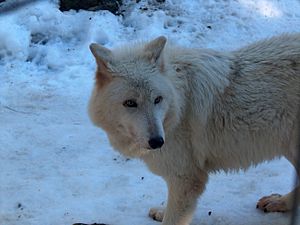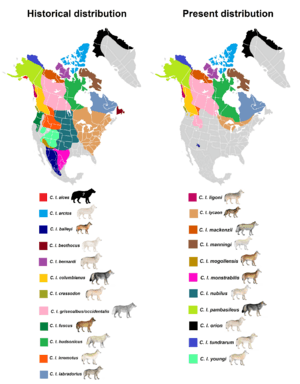Vancouver Coastal Sea wolf facts for kids
Quick facts for kids Vancouver Coastal Sea wolf |
|
|---|---|
 |
|
| Captive wolf at Grouse Mountain | |
| Conservation status | |
| Scientific classification |
|
| Kingdom: | Animalia |
| Phylum: | Chordata |
| Class: | Mammalia |
| Order: | Carnivora |
| Family: | Canidae |
| Genus: | Canis |
| Species: | |
| Subspecies: |
C. l. crassodon
|
| Trinomial name | |
| Canis lupus crassodon Hall, 1932
|
|
 |
|
| Historical and present range of grey wolf subspecies in North America | |
| Synonyms | |
|
Canis crassodon crassodon |
|
The Vancouver Coastal sea wolf (Canis lupus crassodon), also known as the Vancouver coastal island wolf, is a special type of grey wolf. These wolves live only in the Great Bear Rainforest and on northern Vancouver Island along the Pacific Northwest Coast of North America. They are often called sea wolves because of their unique lifestyle.
Sea wolves live in groups called packs, usually with five to twenty wolves. Their diet is quite unusual for wolves. In some coastal areas, fish is their main food, making up 90 percent of what they eat. Salmon alone can be almost a quarter of their diet! They also find food like barnacles, clams, herring eggs, seals, river otters, and even whale carcasses. Sometimes, these wolves will also hunt deer and small mammals.
Contents
What Do Sea Wolves Look Like?
The Vancouver sea wolf is a medium-sized wolf. It stands about 26 to 32 inches (66 to 81 cm) tall. From its nose to the tip of its tail, it measures about 4 to 5 feet (1.2 to 1.5 meters) long. These wolves usually weigh around 60 pounds (27 kg).
Their fur is typically a mix of grey, brown, and black colors. Sometimes, you might even see a sea wolf that is completely white.
How Do Sea Wolves Behave?
Sea wolves from the Great Bear Rainforest are amazing swimmers. They are fast and powerful in the water. They move very quietly, with most of their bodies submerged. Only their eyes, ears, and snouts peek above the surface. Many sea wolves swim from one island to another throughout the year.
Sometimes, they follow the salmon runs, but they also appear when there are no salmon. This is because sea wolves have a very varied diet. A recent study found that up to 90 percent of their food comes from the ocean. Single wolves can hunt seals and otters. Packs have even been seen eating parts of whale carcasses.
These carnivores also enjoy shellfish. They use their paws to dig for clams in the sand. They also use their strong jaws to crack open the shells of mussels.
Sea Wolves in Local Stories
The unique lifestyle of these fish-eating sea wolves inspired old stories. Mythical creatures like Gonakadet and Wasgo are found in the traditions of the Tsimshian, Tlingit, and Haida peoples. These groups live in British Columbia and Alaska.
How Are Sea Wolves Classified?
The sea wolf is officially recognized as a subspecies of Canis lupus (the grey wolf). This classification is listed in a major book called Mammal Species of the World (2005).
Scientists have studied the DNA of these wolves. They found that coastal wolves in southeast Alaska are genetically different from grey wolves living inland. This means they have unique genetic traits. These studies suggest that coastal wolves are the last remaining members of a group that used to live across a much wider area.
Another study showed that wolves along the coast of British Columbia are genetically and ecologically different from inland wolves. This includes other wolves from inland British Columbia.
Why Are Sea Wolves Unique?
In 2016, two studies looked at the DNA of many North American grey wolves. They found that coastal wolves are genetically and physically distinct from other wolves. They live in the same type of habitat and hunt similar prey.
These coastal wolves form one of six "ecotypes" identified by the study. An ecotype is a group of animals that are genetically and ecologically unique. They are separated from other groups because they prefer a different type of habitat. Wolves that eat fish and small deer in wet, coastal areas tend to be smaller than other wolves. This shows how wolves adapt to their local environment.
See also
 In Spanish: Lobo de Vancouver para niños
In Spanish: Lobo de Vancouver para niños


